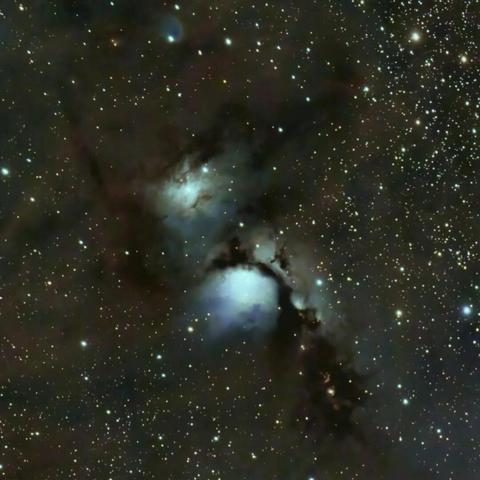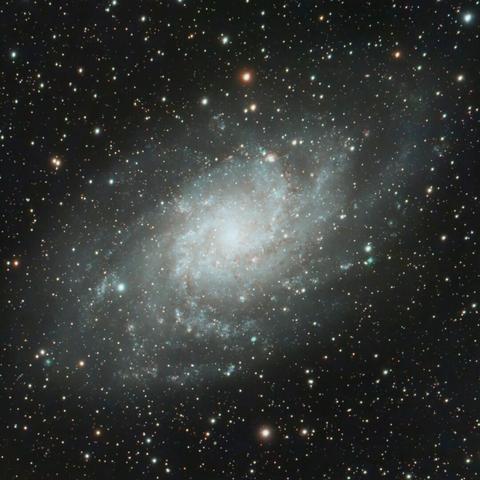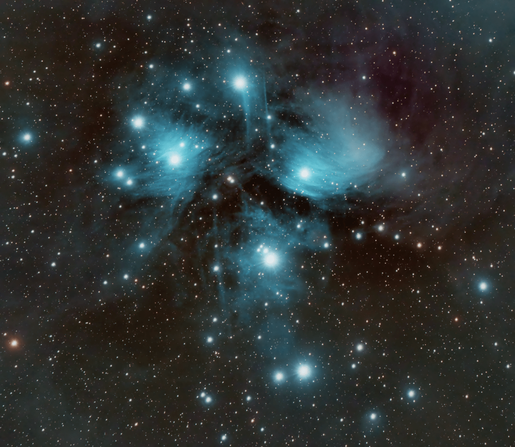Mollenberg Observatory
Astrophotography, skiing and climbing and anything else I see fit to post. American grown, German based. 🇺🇸 🇩🇪 🇺🇦 🌎
@smilingj@astrodon.social yeah I agree in retrospect ☺️ new edit!
The small and the large
The Small Magellanic Cloud (SMC) and Large Magellanic Cloud (LMC) are two dwarf irregular galaxies near our own Milky Way.
At between 150 and 200 thousand light years from Earth, these are two of the furthest objects visible with the naked eye, although these two images were taken with a wide field telescope in Chile.
The data was collected with the new T70 telescope at the itelescope facility in Chile and provided through their member's data feed.
Processing in APT and PixInsight.
#astrophotography #nebula #tarantulanebula #milkyway #deepsky #astronomy #smallmagellaniccloud #starrynight #universetoday #caldwell103 #30doradus #lmc #largemagellaniccloud #space #nasa #esa #c103 #itelescope
The Small Magellanic Cloud (SMC) and Large Magellanic Cloud (LMC) are two dwarf irregular galaxies near our own Milky Way.
At between 150 and 200 thousand light years from Earth, these are two of the furthest objects visible with the naked eye, although these two images were taken with a wide field telescope in Chile.
The data was collected with the new T70 telescope at the itelescope facility in Chile and provided through their member's data feed.
Processing in APT and PixInsight.
#astrophotography #nebula #tarantulanebula #milkyway #deepsky #astronomy #smallmagellaniccloud #starrynight #universetoday #caldwell103 #30doradus #lmc #largemagellaniccloud #space #nasa #esa #c103 #itelescope
Large Magellanic Cloud
The Large Magellanic Cloud (LMC), is a satellite galaxy of the Milky Way. At a distance of 160,000 ly, it is one of our next galactic neighbors. The LMC is approx. 32,200 ly across, with 1% the mass of our own galaxy. Despite this, is the fourth-largest galaxy in the Local Group, after Andromeda, Milky Way and Triangulum galaxies.
LMC is host to hundreds of astronomical features with their own designations, including Tarantula Nebula, the brightest point in this image, featured center-left.
This wide field image spans over 10 degrees squared, by comparison the moon is only half a degree in diameter! The RGB data was collected with the new T70 telescope at the itelescope facility in Chile and provided through their member's data feed. Processing in APP and PixInsight.
#astrophotography #nebula #tarantulanebula #milkyway #deepsky #astronomy #starrynight #universetoday #caldwell103 #30doradus #lmc #largemagellaniccloud #space #nasa #esa #c103 #itelescope
The Large Magellanic Cloud (LMC), is a satellite galaxy of the Milky Way. At a distance of 160,000 ly, it is one of our next galactic neighbors. The LMC is approx. 32,200 ly across, with 1% the mass of our own galaxy. Despite this, is the fourth-largest galaxy in the Local Group, after Andromeda, Milky Way and Triangulum galaxies.
LMC is host to hundreds of astronomical features with their own designations, including Tarantula Nebula, the brightest point in this image, featured center-left.
This wide field image spans over 10 degrees squared, by comparison the moon is only half a degree in diameter! The RGB data was collected with the new T70 telescope at the itelescope facility in Chile and provided through their member's data feed. Processing in APP and PixInsight.
#astrophotography #nebula #tarantulanebula #milkyway #deepsky #astronomy #starrynight #universetoday #caldwell103 #30doradus #lmc #largemagellaniccloud #space #nasa #esa #c103 #itelescope
Does anyone out there know how I can use the "show more" feature with the text content so the image is featured more prominently? I've seen it on other folks posts but not clear how it works. Using Tusky here
Messier 78 (aka NGC 2068)
M78 is a reflection nebula in the constellation Orion. M78 is part of the massive the Orion B molecular cloud complex. It is approx. 1,350 light-years from Earth.
This image integrates approx. 44 x 300 second subframes taken on 30 October 2022, since then it's been awful weather but tonight looks promising. Processing in APP and PixInsight.
#astrophotography #astronomy #starrynight #dso #deepsky #nightskyphotography #milkyway #space #nasa #esa #nebula #asi294mcpro #explorescientific #ed80 #messier78 #messierobjects #clearskies #longexposure #universetoday #nightimages #ngc2068
M78 is a reflection nebula in the constellation Orion. M78 is part of the massive the Orion B molecular cloud complex. It is approx. 1,350 light-years from Earth.
This image integrates approx. 44 x 300 second subframes taken on 30 October 2022, since then it's been awful weather but tonight looks promising. Processing in APP and PixInsight.
#astrophotography #astronomy #starrynight #dso #deepsky #nightskyphotography #milkyway #space #nasa #esa #nebula #asi294mcpro #explorescientific #ed80 #messier78 #messierobjects #clearskies #longexposure #universetoday #nightimages #ngc2068
Back in August, I did a couple of nights on Messier 33, the spiral galaxy in the constellation Triangulum. A week later, over 80 liters of rain (and hail) fell in just moments causing road closures, flooded cellars and lots more chaos. We spent weeks drying out 😳
This is 123x200 seconds of data over two or three nights. One of my favorite targets, I always come back to it, I think this might be my best image of it so far 😎
Messier 33 is a nearby galaxy at 2.7 million ly from Earth. It has a diameter of 60,000 ly, that's about 2/3 the size of the #milkyway. With an angular size of 70x41 minutes of sky, it is larger than the full moon but quite dim. This image was taken with the open source imaging software, #ninastronomy and post-processed in APP and PixInsight.
#galaxy #astrophotography #astronomy #dso #deepskystacker #deepsky #nightimages #nightskyphotography #nasa #esa #spiralgalaxy #messierobjects #astrophotography #space #longexposure #nightimages #night_shooterz #earthsky #stellarium #milkyway #space #toplongexposure #night #practicalastrophotography
This is 123x200 seconds of data over two or three nights. One of my favorite targets, I always come back to it, I think this might be my best image of it so far 😎
Messier 33 is a nearby galaxy at 2.7 million ly from Earth. It has a diameter of 60,000 ly, that's about 2/3 the size of the #milkyway. With an angular size of 70x41 minutes of sky, it is larger than the full moon but quite dim. This image was taken with the open source imaging software, #ninastronomy and post-processed in APP and PixInsight.
#galaxy #astrophotography #astronomy #dso #deepskystacker #deepsky #nightimages #nightskyphotography #nasa #esa #spiralgalaxy #messierobjects #astrophotography #space #longexposure #nightimages #night_shooterz #earthsky #stellarium #milkyway #space #toplongexposure #night #practicalastrophotography
The Pleiades (AKA Seven Sisters, Messier 45, M45) is an open star cluster with considerable nebulosity (Maia and Merope Nebulae are both located within the cluster). Located in the constellation of Taurus, it is one of the brighter night sky objects (mag. 1.6) and easily visible with the naked eye. The Pleiades holds a place in the stellar folklore of most cultures, some may recognize the constellation as the logo of the Japanese automotive brand Subaru (スバル), its namesake.
At approximately 444 light years distant, it is one of the nearest star clusters to Earth, and the nearest messier object. Easily visible with the naked eye, it has an angular size of 110 minutes, or nearly two degrees of arc. At magnitude 1.6.
The cluster is dominated by hot blue and luminous b-type stars that have formed within the last 100 million years. Astronomers estimate that the cluster will survive for about another 250 million years, after which it will disperse due to gravitational interactions with its galactic neighborhood.
This image integrates the best 40 (of over 100!) exposures taken on October 27th 2022.
#sevensisters #nebula #opencluster #starcluster #messier45 #messierobjects #astrophotography #astronomy #milkyway #space #toplongexposure #night #practicalastrophotography
At approximately 444 light years distant, it is one of the nearest star clusters to Earth, and the nearest messier object. Easily visible with the naked eye, it has an angular size of 110 minutes, or nearly two degrees of arc. At magnitude 1.6.
The cluster is dominated by hot blue and luminous b-type stars that have formed within the last 100 million years. Astronomers estimate that the cluster will survive for about another 250 million years, after which it will disperse due to gravitational interactions with its galactic neighborhood.
This image integrates the best 40 (of over 100!) exposures taken on October 27th 2022.
#sevensisters #nebula #opencluster #starcluster #messier45 #messierobjects #astrophotography #astronomy #milkyway #space #toplongexposure #night #practicalastrophotography
Client Info
Server: https://mastodon.social
Version: 2025.04
Repository: https://github.com/cyevgeniy/lmst


